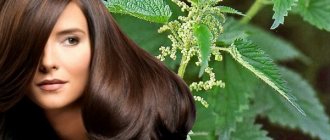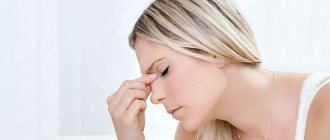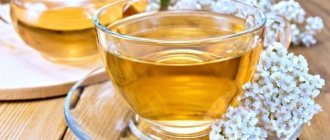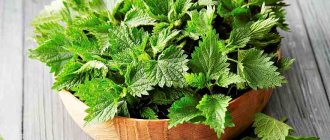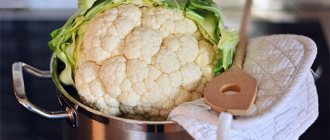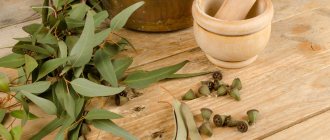Useful types of nettles
- Stinging nettle is most often used in folk medicine. It is also called medicinal nettle, as well as stinging nettle, goad, and zhigalka. This type of nettle is distinguished by a high stem - up to one and a half meters in height. The leaves of the plant are large.
- Stinging nettle is not tall, up to 60 cm. It has small, ovoid leaves. The hairs on the leaves of the plant are very hot.
- Gill-leaved nettle is also useful, but is not used as often as other types. The leaves are large, the nettle reaches a height of one meter. There are hairs that burn, and there are hairs that don’t.
How to make a nettle decoction for rinsing hair
Nettle for decoctions is taken fresh and dried, as an independent element and in combination with other substances and plants. The final composition of a medicinal or cosmetic product will depend on what effect a person wants to achieve. Buying nettles at the pharmacy is inexpensive, but young shoots collected yourself will bring particular benefits. If it was not possible to use all of it, the remains of the plants should be dried in order to make decoctions with healing properties in the cold season. Rules for collecting herbs:
- Harvest nettles while it is not raining or humid outside, between May and June, when they bloom.
- Do not touch plants whose leaves or stems are damaged.
- Don't forget to wear gloves to protect your hands from the stinging nettle hairs.
- Before preparing a decoction with a fresh plant, rinse it well.
How to dry:
- Make a canopy so that the sun's rays do not hit the plant, in a well-ventilated room.
- Spread the collected grass underneath it.
- Wait a little more than a week, maximum two.
- Separate the leaves from the stems.
- Place the leaves in paper bags and close them well.
- Store for no more than 2 years (preferably until the next harvest season).
Classic recipe from young nettles
A decoction of fresh nettle is an excellent remedy that will help get rid of dandruff, give your hair more strength and shine, and is good for gray hair. To prepare a decoction, take one hundred grams of a young plant and rinse well. Separate the leaves, place them in a saucepan or bowl, add a liter of hot water, and boil for about half an hour. The fire should be slow. Strain the resulting liquid. Rinse your hair with nettle decoction:
- Prepare a liter of boiled or filtered water, add 0.5 tsp. soda, pour 250 milliliters of concentrated broth.
- Using a convenient container with a handle, rinse your hair for about five minutes, tilting it over the bathtub.
- Wrap your head in a towel and pat lightly, but do not dry
- Do not use a hairdryer; let the strands dry on their own. From the first use you will see high efficiency - shine, shine.
With burdock for growth
Combined decoctions will help to have a comprehensive effect on hair problems. Burdock is a plant that contains many vitamins. The famous burdock oil is obtained from its roots. The ideal option is to prepare a decoction with nettle and burdock root in a water bath, this way the healing substances will be better preserved. Take both plants in equal proportions, place them in a small container with cold, clean water, and place this in a larger pan that will sit on the fire. Do not bring to a boil. After preparation, leave the product to infuse for 1-2 hours.
- Hedgehogs in a slow cooker - recipes with photos. How to cook hedgehogs from minced meat with rice and sauce in a slow cooker
- White discharge in women
- Diuretic herbs and preparations - list. What diuretic herbs to drink for high blood pressure, edema and weight loss
With added chamomile for strengthening
A decoction of chamomile and nettle is used when you need to normalize the functioning of the sebaceous glands or lighten your hair slightly. Take 100 grams of each plant and 30 grams of black tea. All ingredients are mixed together and poured with two liters of boiling water. Next, the resulting mixture should be simmered over low heat for about half an hour, then removed from the stove and allowed to brew until cooled. Before use, the decoction must be strained. The resulting natural product is used as a root lotion or as a rinse after washing hair with harmful alkaline shampoos.
Recipe for infusion against hair loss
Nettle decoction has a wonderful effect on hair and its growth. To prevent hair loss and strengthen the follicles, a person can prepare the following decoction: pour dry leaves of the plant (4 tablespoons) with a liter of boiling water and let it brew under a saucer or lid. When thirty minutes have passed, add a spoonful of honey to the product, which should quickly dissolve, then cover the mixture for another half hour. When using this decoction for rinsing, you need to lightly rub it with your fingers into the scalp. It is better to ensure drying without a hair dryer.
Procurement of raw materials
The easiest way to purchase nettles is at a pharmacy. It is sold dried in cardboard packs, packaged in 50 grams. But, if you live in a rural area, you can prepare nettles yourself. It is better to choose plants that grow away from roads and factories.
You can start collecting nettle leaves in May. And all summer until August you can pinch off nettle leaves to brew tea, make soups, and salads.
It is better to use gloves to collect leaves to avoid getting burned. After the leaves are collected, they need to be dried. It is better to place the leaves in rooms where the air is well ventilated. The air temperature should not be higher than 40 degrees.
The roots also have beneficial properties. They are dug up in autumn or spring. Then they are washed and dried in the fresh air. In the fall, you can also prepare the seeds of the plant. To do this, the shoots are cut, then dried and threshed.
You can store harvested raw materials in fabric or paper bags. For two years, the healing properties of nettle are preserved.
Cooking recipes
Traditional medicine recipes allow you to teach stinging nettle in the form in which it is truly beneficial for health.
You can collect and dry nettles yourself or purchase pharmaceutical herbs.
It is preferable to collect leaves in the first 2-3 weeks of summer. Any protective gloves should be used to protect against burns. To dry, the leaves can be laid out on parchment paper (or newspaper) and left in this position for several days. Sunlight is not a hindrance and accelerates the evaporation of moisture.
Let's look at the most popular recipes.
Decoction
What you will need:
- 2 tbsp. l. dry nettle;
- 500 ml boiling water.
Recipe:
- Steam the raw materials with boiling water.
- Let it brew for 3 hours. Cover the container with a lid.
- Strain.
- Cook over low heat for 30-40 minutes.
- Sue again.
Nettle decoction is used for stomach disorders, to prevent exacerbation of chronic intestinal diseases (gastritis, duodenitis, stomach and duodenal ulcers), for heavy blood loss during menstruation, as well as for infections of the urinary system (cystitis, pyelonephritis). Drink 200 ml 2 times a day. Duration of therapy is up to 3 weeks.
The decoction can also be used to rinse the mouth during inflammatory processes (stomatitis, gingivitis, periodontal disease). Rinsing is performed 2-3 times a day.
Alcohol tincture
Ingredients:
- 150 grams of dried herbs;
- 300 ml of vodka (moonshine or medical alcohol should not be used);
- 300 ml water.
How to cook:
- Pour alcohol into dry raw materials. It is recommended to use any glass container with a tight lid.
- Shake well, add water. Close the lid.
- Place for 2 weeks in any dark, cool place. It is recommended to shake the vessel every 1-2 days.
- Filter. Keep refrigerated.
The remedy is effective for colds, bronchitis or tracheitis with a persistent dry cough, and general loss of strength. Take 1-2 tsp. 3 times a day after meals.
Tea
Ingredients:
- 2 tbsp. l. dried nettle leaves;
- 600 ml of hot water (temperature 85-90 °C).
How to do:
- Brew the herb with boiling water.
- Mix well. Leave for 40-50 minutes.
- Strain.
Nettle tea is taken to maintain appetite, lose weight and improve the overall health of the body, and lower blood sugar levels. You can drink 3 glasses (200 ml) of tea per day, 1 hour after meals. The course lasts up to 2-3 weeks.
At the pharmacy you can buy nettle tea in bags or loose form.
Juice
The recipe requires 400-500 grams of fresh nettle leaves.
Cooking technology:
- Rinse fresh nettles thoroughly under water. Pour boiling water over.
- Place in blender. Grind until smooth.
- Pass through cheesecloth.
Under no circumstances should the juice be taken orally. It is used topically to heal damaged skin (ulcers, abrasions, cuts).
There are many folk recipes for using nettles. Each of them is unique and can save a person from a certain number of ailments.
What does nettle contain?
An ordinary-looking grass, a weed, contains a huge amount of useful elements. Among them:
- Vitamins of all groups, including rare vitamin K.
- Plant protein.
- Macroelements (sodium, potassium, magnesium, phosphorus).
- Microelements (cobalt, iron, zinc, cobalt, iodine).
- Acetylcholine.
- Various acids.
- Chlorophyll.
- Protein compounds.
- Tannins.
You may be interested in: Is it possible to drink tea for stomach ulcers?
Nettle decoction: beneficial properties
- Has an anti-inflammatory effect.
- Improves metabolic processes, removes toxins from the body.
- Normalizes the functioning of the bladder and liver.
- Has hemostatic properties.
- Fights germs, kills bacteria.
- Strengthens the entire body as a whole.
- Normalizes the menstrual cycle, contracts the uterus, eliminates PMS pain.
- Increases the number of red blood cells, platelets, and increases hemoglobin levels.
Benefits and harms
Like any drug or medicinal substance, nettle has medicinal properties and contraindications (they will be discussed a little later). The plant contains a large number of chemical microelements. For example, vitamin K contained in nettle improves blood clotting and has an anti-inflammatory effect. In addition, this substance is involved in the process of hematopoiesis and promotes the formation of bone tissue.
The burning plant contains formic acid, flavonoids and tannins. Previously, it was even possible to save a person from death in case of severe frostbite. To do this, the affected areas of the body were simply wrapped in a blanket of nettles.
The plant also contains protein, and it is twice as much as in legumes. Thanks to cellulose polysaccharides, lignins and vitamins B, C, E, K, also included in nettle, there is a rapid removal of various toxins from the body.
Many of us know that the body needs beta-carotene to improve visual acuity. It turns out that it is found not only in carrots, but also in nettles.
To understand all the beneficial properties of the burning plant, you need to carefully familiarize yourself with its chemical composition. 100 g of nettle contains 0.5 g of fat, 5.4 g of carbohydrates, all of the above vitamins, 3.1 g of fiber and 3.7 g of protein. It also contains calcium, zinc, phosphorus, selenium, iron, chlorine and copper.
Nettle has an anti-inflammatory and healing effect, improves blood clotting and eliminates dark circles under the eyes. The plant is used for chronic diseases, atherosclerosis and tuberculosis. With weak immunity, nettle stimulates carbohydrate-protein metabolism in the body.
Nettle decoction in gynecology
In gynecology, nettle is used quite widely. It is used for various diseases. Nettle decoction, reviews of which are very positive, is used both for internal use and for baths and douches.
For cervical erosion
To prepare the decoction you need to take:
- 200 ml boiling water
- 2 tbsp. spoons of bergenia roots
- 1 spoon nettle
First you need to boil the bergenia in water for about half an hour. Then add nettles and leave the mixture on the fire for another five minutes. Strain the broth, and as soon as it cools, use it for douching. You will need to do 3-4 douches per day for the erosion to begin to heal.
For vaginitis
For a decoction for vaginitis we take:
- 500 ml boiling water
- 1 tbsp. spoon of chamomile
- 1 tbsp. spoon of nettle
Pour boiling water over the grass and leave for at least half an hour. Then we filter. We use the resulting liquid for douching twice a day.
To prepare a decoction for oral administration, take:
- 200 ml boiling water
- 1 tbsp. spoon of St. John's wort
- 1 tbsp. spoon of nettle
Pour boiling water over the St. John's wort herb and keep it on the fire for 20 minutes. Then add nettles. Filter the mixture. Drink a spoonful at a time.
During menopause
To get rid of unpleasant symptoms during menopause, take a glass of boiling water and a spoonful of nettle leaves. Infuse the mixture overnight. In the morning you need to strain the solution. You need to drink a decoction of nettle leaf three times a day, a spoonful before meals.
You may be interested in: Thyme: properties and contraindications for women
For heavy periods
To prepare a nettle decoction for menstruation, you need to take a spoonful of stinging nettle leaves in a glass of water. It is better to use a ceramic teapot or thermos. The mixture must be left to steep for at least two hours. With heavy menstruation, you need to drink a teaspoon three times a day.
Fresh nettle juice is very useful. We extract juice from nettles, dilute a teaspoon of juice in 50 ml of water. This solution is drunk before meals three times a day.
If heavy periods are regular, you should not self-medicate. It is recommended to consult a doctor, because heavy menstruation can be the first sign of a serious illness.
You should not use nettle infusion to stop or induce menstruation. This is very harmful to the female body.
Recipe
Now let’s discuss how to prepare a nettle decoction , be it a purchased plant or the leaves you collected:
- Pour one tablespoon of leaves into 0.2 liters of water;
- Boil;
- Leave to sit under a towel for an hour;
- Strain and cool.
We also recommend: Sulfur dioxide in wine
How to drink nettle decoction for various diseases?
For anemia and weakened immunity, 50 ml before each meal;- For impaired blood clotting, 200 ml per day, divided into four equal doses;
- For diabetes mellitus, a glass daily;
- If you have skin problems, take a glass a day orally or to wipe the affected areas with a cotton pad;
- For external and internal bleeding, 4 glasses daily;
- To combat obesity and speed up metabolism, it is enough to drink 50 ml daily (in four doses);
- To strengthen your hair, wash it with liquid every morning;
- To normalize the functioning of the nervous system and improve sleep, you need to drink a glass a day, dividing it into small portions.
Nettle decoction for bleeding
But nettle can stop bleeding. For example, a decoction of nettle is used for nosebleeds. You can soak a cotton swab in it and place it in your nostril. The blood will stop quickly. Nettle juice is even more beneficial than decoction. It helps damaged capillaries recover faster.
Use in traditional therapy
Bleeding (including metrorrhagia, pulmonary hemorrhage, hematuria, intestinal and hemorrhoidal bleeding); hypovitaminosis; atherosclerosis; cholecystitis, peptic ulcer of the stomach and duodenum, constipation, enterocolitis; long-term non-healing purulent wounds, trophic ulcers, furunculosis, lichen, acne, bedsores;
How is nettle used in folk medicine? What medicines can be prepared from it at home? What drugs are available at the pharmacy?
Pharmacy drugs
- Oil. Most often used externally in dermatology and cosmetology for skin and hair care. You can make an oil extract from nettles at home.
- Dry nettle extract. You can buy dietary supplements in the form of tablets and capsules, which are made from dried nettle root. Powder made from dry extracts of leaves and roots is also sold. It is used to prepare infusions at home.
- Liquid extract. Sold in 100 ml bottles. The indications for use indicated in the instructions are diseases of the urinary system and joints, iron deficiency anemia, inflammation of the prostate gland, uterine bleeding, menstrual irregularities. The herbal preparation is prescribed in complex therapy with synthetic drugs. Take in a strict dosage - no more than 30 drops 4 times a day.
- Dry vegetable raw materials. The instructions for using nettle leaves indicate age restrictions - the herb is allowed for children from 12 years of age. An overdose can cause an allergic reaction and increased blood clotting. Therefore, it is so important to follow the dosage when preparing the infusion: take no more than 2 tbsp per 200 ml of water. spoons of dry raw materials.
Nettle infusion can be prepared from leaves, roots and seeds.
Preparation of a decoction of leaves
- Take 1 tbsp. l. dry raw materials.
- Pour a glass of boiling water.
- Boil for 1 minute.
- Insist for half an hour.
They drink for all the diagnoses listed above. Externally, decoctions and infusions are used in the form of baths, lotions, warm poultices, and compresses.
Preparation of a decoction of roots
- Take 1 tsp. ground roots.
- Pour a glass of boiling water.
- Boil for 1 minute.
- Insist for half an hour.
This decoction is useful for cleansing the blood of toxins; it is drunk for furunculosis, swelling, hemorrhoids, and heart disease. It is used externally for skin lesions - eczema, lichen, urticaria, burns. There is also a recipe for cooking roots in syrup. This is an effective cough remedy.
Preparing a decoction from seeds
- Take 1 tsp. seeds (preferably crushed).
- Pour a glass of boiling water.
- Boil for 1 minute.
- Leave for 1 hour.
This decoction is useful for men - it increases potency and enhances sexual activity. You can also infuse the seeds in red wine or add honey to the infusions.
How to drink nettle decoction?
- Be sure to strain before use.
- Take in the following dosage: 1 tbsp. l. 3 times a day before meals.
- A decoction of the roots can be taken in a larger dosage - ¼ cup 3 times a day.
- The course of treatment depends on the diagnosis and age of the patient and is prescribed by the doctor.
- Long-term use should be limited in old age to prevent thrombophlebitis.
- The prepared broth can be stored in the refrigerator for no more than 2 days.
Infusion
What are the uses of nettle infusion? This remedy is effective for all of the above indications. The infusion is especially useful for stopping bleeding. It is also an excellent multivitamin drink. To prepare the infusion, you can use crushed leaves or nettle bags from the pharmacy.
Preparation
- Take 1 tbsp. l. dry raw materials.
- Pour a glass of boiling water.
- Leave for 1-2 hours.
- Strain.
It is also a good tonic, restorative, and lactogenic agent. It is often drunk for rheumatism. The infusion is used externally in the same way as a decoction. For external use and cleansing of the skin, an infusion of celandine and nettle is recommended.
Preparation of fortified infusion
- Take equal parts of nettle, rose hips, currants, and carrot root.
- At 2 tbsp. l. mixture, take 2 cups of boiling water.
- Leave for 1 hour.
- Strain.
Tincture
This is a good sedative for nervous disorders, apathy, drowsiness, and lethargy. It acts as a tonic, so it is not recommended to take it in the afternoon. The tincture is also used as a rub for joint and muscle pain. Taken orally for whooping cough, diseases of the bronchi and lungs. Red wine tincture with honey also helps with coughs.
Preparation of vodka tincture
- Take 1 part of dry leaves.
- Pour in 5 parts vodka.
- Soak it in the sun for 2 weeks.
- Strain.
A tincture can also be prepared from the roots.
Syrup with nettle and hogweed extract is sold in pharmacies. It is used for hormonal imbalances, a number of gynecological diseases, infertility, mastopathy, and to strengthen the immune system. But you can also make syrup yourself.
Syrup recipe
- Pass 1 kg of fresh leaves through a meat grinder.
- Add 3 cups of water.
- Boil for 2 minutes and strain.
- Add ½ kg of honey and stir thoroughly.
The syrup should be stored in the refrigerator. This is a good multivitamin and general tonic. You can take 1 tsp. This syrup also makes delicious fortified drinks.
Fresh nettle juice can replace decoction and infusion. It is used internally and externally. Drink 20 minutes before meals 3 times a day, 1 teaspoon. Effective for kidney and gallstones, uterine and nosebleeds, iron deficiency anemia, hypovitaminosis. The juice is drunk to stimulate the nervous system and for toothache. It is used as an antiseptic for diseases of the oral mucosa and inflammation of the skin.
Cosmetology
What are the benefits of nettle for hair and skin? The herb contains minerals, organic acids and vitamins that provide anti-inflammatory, nutritional, rejuvenating, and antioxidant effects.
- For problematic skin. Used externally in the form of decoctions and infusions. Alcohol tincture can only be used in diluted form for oily skin. Cleanses the skin well with acne and purulent wounds. For furunculosis, the herb is also taken orally.
- For hair. In case of hair loss, oily hair, or dandruff, it is recommended to rinse your hair with decoctions. For oily scalp, you can rub the tincture. Herbal mixtures with the addition of chamomile, burdock root, and oak bark are often used. Read more about using nettle for hair in our other article.
- Bath with nettles. This is not only a cosmetic, but also a medical procedure. Cleanses the skin well, renews cells, relieves swelling, helps with women's diseases and nervous disorders. Decoctions of nettle and sage are used to make baths for hands and feet, which soften the skin well, eliminate sweating of the palms and feet, and strengthen nails.
Preparation of oil
- Take 1 part of the crushed root.
- Pour in 2 parts olive oil.
- Leave for 2 weeks.
- Strain.
The oil is widely used in cosmetology: it is rubbed into the scalp, it is used to treat rough, chapped skin, cracks, wounds and scratches. The product is also effective in dermatology, in the treatment of burns.
The concentration of the drug and the time during which it is infused may vary depending on the final purposes of using the drug. Therefore, it is necessary to dwell in more detail on the description of specific methods of its preparation for the treatment of various groups of pathologies.
To prepare a medicine for anemia and immunodeficiency conditions, 4 fresh nettle leaves (or 1 tablespoon of dried raw material) are brewed in a glass of water and left for 25 minutes. The resulting product is drunk 50 ml shortly before eating.
To increase the number of red blood cells and subsequently increase the rate of blood clotting, drink a decoction prepared at the rate of 5 fresh nettle leaves (or 1.5 tablespoons of dried plant material) per 250 g of boiling water. Drink 200 g of the drink per day, dividing the total dose into four equal doses.
Acne, pimples
To treat acne and pimples, 50 g of dried medicinal raw materials are brewed with a liter of water and left for 30 minutes. The medicine is taken orally, one glass per day or used to wipe the affected areas.
Diabetes
To prepare a drug that lowers blood sugar, not only nettle leaves are used, but also lingonberries or blueberries (20 grams of dry leaves and a tablespoon of berries per 300 g of water). The decoction is infused for half an hour. Drink a glass of the product per day, dividing the daily portion into several small doses.
DETAILS: Penile curvature urology
For hemorrhoidal and internal bleeding, as well as for heavy, prolonged menstruation, take a nettle decoction orally, prepared at the rate of 60 g of leaves per 750 g of water. The product is infused for 40 minutes and drunk 4 glasses a day. For external hemorrhoids, lotions soaked in it are applied to the prolapsed nodes.
Obesity
To speed up metabolic processes, a tablespoon of nettle leaves is brewed with 200 g of water and left for 35 minutes. The finished product is drunk throughout the day, dividing it into 4 doses.
Hair diseases
To combat dandruff and pathological hair loss, use a decoction prepared at the rate of 3 tbsp. spoons of dry nettle per ? liters of water. Leave the product for 20 minutes and rinse cleanly washed hair with it. It is worth noting that regular use of nettle decoction helps strengthen the hair structure, make it shiny and beautiful.
To prepare a sedative, brew a tablespoon of dry nettle in a glass of water and leave for 9 hours. The product is drunk on an empty stomach shortly before meals three times a day.
There is another recipe that allows you to cope with disturbances in the functioning of the nervous system. To prepare a sedative, dried oregano herb (1 tbsp) and nettle leaves (1 tbsp) are brewed in a glass of water, boiled for a quarter of an hour and left for 40 minutes. The resulting decoction is drunk throughout the day, divided into many small portions.
The use of nettle in cosmetology
It is justified to use nettle decoction to improve the condition of hair and skin.
- Boil 100 g of nettle in half a liter of boiling water for 15 minutes. Then wait until it cools down and strain. Add 0.5 cups of table vinegar to the broth. After filtering, you can wash your hair. It must be used within 10 days. Shampoos should not be used during treatment.
- You can rinse your hair with nettle decoction after washing. This will strengthen the hair, make it soft, manageable, and shiny.
- An infusion of nettle leaves with the addition of coltsfoot herb helps strengthen hair. Mix the herb in equal parts. Fill three spoons with a liter of clean water. After the broth has infused, you need to strain it and rinse your hair. You can rub nettle decoction for hair into your scalp twice a week.
What are the benefits of washing your hair with nettle decoction?
The beneficial substances that ordinary nettle is rich in make it indispensable in the fight against certain scalp diseases, and also help restore shine to hair and make hair less dull and weak. The plant is used to get rid of gray hair and stop the loss of pigment: for this, not only nettle decoctions are prepared, but also masks. What healing elements does the plant contain and how is a nettle decoction based on it useful for hair:
- Vitamin A. Thanks to this element, the scalp becomes better, minor damage heals, it provokes hair growth from inactive follicles and accelerates metabolic processes.
- Vitamin C. Helps scalp cells receive oxygen more actively, so hair grows much faster.
- Vitamin K. Returns shine, improves hair condition, gives a beautiful natural glow.
- Beta carotene. Useful for those who have increased oil production on the scalp. This element moisturizes and normalizes the functioning of the sebaceous glands.
- Tannins. Promotes smoothness and elasticity of hair, because... cause the scales of which it consists to stick together and fit more tightly to each other.
- Flavonoids. They help the hair to stay better in the sprout area, so hair loss will be reduced.
- Organic acids. They make hair growth more active because they regulate the metabolism of the scalp.
